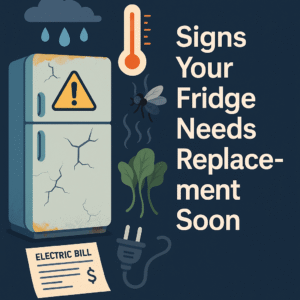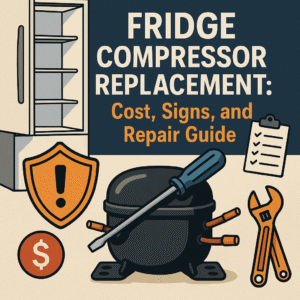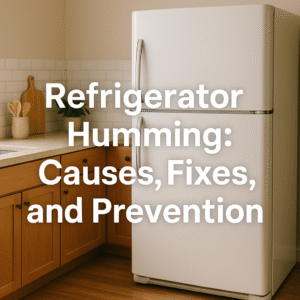Is your dryer not heating and leaving clothes damp after a full cycle? You’re not alone. A dryer that won’t heat up can be caused by several common issues – from simple user settings to clogged vents or faulty parts. In this guide, we’ll walk you through the most frequent reasons a dryer fails to heat and offer practical, step-by-step solutions for both electric and gas models. Read on to learn dryer repair tips that could save you time and money, and know when it’s time to call in the pros.
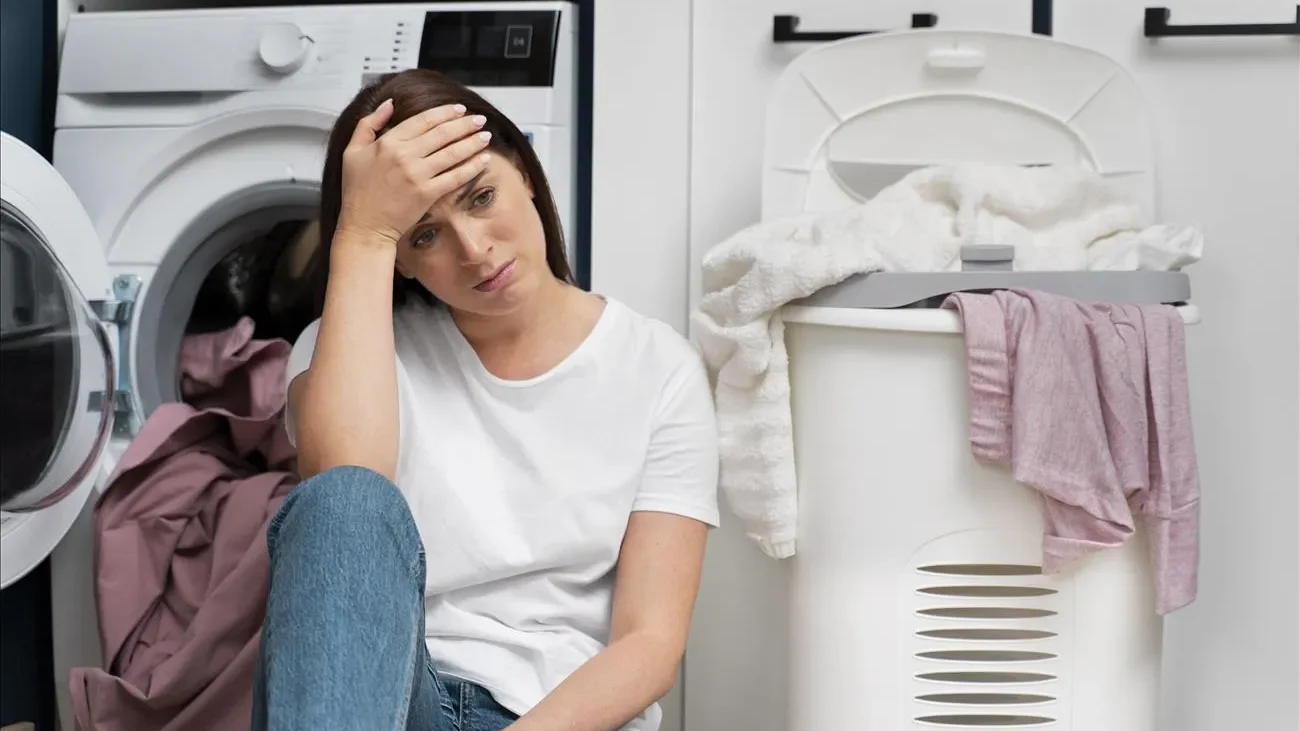
Why Is My Dryer Not Heating?
Before you panic, remember: many dryer-heating issues have simple fixes. In most cases, you can troubleshoot the problem yourself by checking settings and basic components. Below are the most common reasons a dryer won’t heat, along with quick checks for each.
- Incorrect dryer cycle or settings (e.g. “Air Fluff” or “No Heat” mode)
- Power supply issues (tripped breaker, blown fuse, faulty outlet)
- Dirty lint filter or blocked vent restricting airflow
- Faulty heating element (in electric dryers)
- Blown thermal fuse or thermostat (safety devices in all dryers)
- Gas supply or ignition problems (in gas dryers)
- Control board, timer, or sensor malfunctions
- Overloading or soaking laundry (too much moisture to dry)
Read on to diagnose each cause and learn the dryer repair tips to fix it. As you go through these steps, be sure to unplug the dryer or turn off power at the breaker for any checks that involve internal parts or electric components.
Microwave Not Heating? Common Causes & Troubleshooting Tips, Click Here!
1. Incorrect Dryer Settings (Air Fluff/Cool Cycle)
Sometimes the problem is as simple as the wrong setting. Air fluff, tumble, or “No Heat” cycles simply tumble clothes without warm air. Make sure your dryer isn’t set to an eco, air-dry, or cool cycle by mistake. Switch to a higher heat or cotton setting (e.g., High Heat or Normal Dry) and run the dryer again.
- How to fix: Check the dryer control panel. Ensure the cycle dial or digital setting is on a heating cycle (like “Cotton/Regular Dry”) and not on a no-heat option. Confirm the start button is engaged properly.
- Tip: Some dryers have an “Air Only” or “Fluff” option that generates no heat. Double-check and change to “High” or “Auto Dry”.
- Bottom line: Always make sure you select a heating cycle. This might solve the issue immediately.
2. Tripped Circuit Breaker or Blown Fuse (Electric Dryers)
Electric dryers need a full 240 volts to generate heat. If a circuit breaker has tripped or a fuse is blown, the dryer may still tumble but not heat up. This often happens if one of the two hot legs of the circuit is lost – the motor can run on 120V, but the heating element won’t get enough power.
- How to fix: Go to your home’s electrical panel and look for a tripped breaker labeled for the dryer. If the breaker is in the “Off” or middle position, flip it fully off, then back on to reset it. If it trips again immediately, there may be a short or overload, and you should call an electrician or appliance repair tech.
- Check the outlet: If you have a voltmeter, verify the outlet is supplying 240V (you should measure ~120V between each hot leg and neutral, and ~240V between the two hot legs). If you’re not comfortable doing this, skip to the next steps or call a pro.
- Safety Tip: Always unplug the dryer or turn off the breaker before inspecting internal components.
- Quick check: Sometimes dryers also have an internal thermal fuse on the line to the heating element. We’ll cover that in step 5, but resetting power is a good first step for any electrical issue.
- Bottom line: Reset the breaker or replace a blown fuse. If the problem recurs, an electrician should investigate further.

3. Dirty Lint Filter or Clogged Vent (All Dryers)
A clogged lint screen or exhaust vent is one of the most common culprits. When airflow is restricted, a dryer can overheat and shut off its heating element as a safety measure, or simply be unable to transfer heat through the clothes.
Clogged dryer vent full of lint. Regularly clean the lint trap and check the exhaust vent for obstructions to ensure proper airflow.
- Clean the lint filter: After every load, remove and clean the lint screen/trap. If it’s loaded with lint or fabric fuzz, it blocks airflow. Rinse the screen under water and scrub gently with a brush if needed to remove residue or fine lint.
- Inspect the vent hose: Disconnect the vent hose from the back of the dryer (unplug first!). Look for heavy lint buildup or kinks. Vacuum out any lint inside the hose and behind the dryer.
- Check the outside vent: Go outside to where your dryer vents to the exterior. Run a cycle on high heat and check the airflow by placing your hand near the vent. You should feel a strong stream of warm air. If airflow is weak or barely noticeable, the vent is likely clogged.
- Fixing the vent: Use a long dryer vent brush or vacuum attachment to clear lint from the vent pipe. Remove any blockages from the external vent cover. If the vent is crushed or very long, consider replacing it with a smooth (not foil) duct and/or hiring a professional vent cleaning service.
- Why it matters: Blocked vents not only prevent heating, they also pose a fire hazard. Lint is very flammable, so clean the filter every load and ensure the vent is clear at least once a year.
- Bottom line: Clean airflow is essential. A clear lint filter and vent path often restore normal heating.
4. Faulty Heating Element (Electric Dryers Only)
In an electric dryer, the heating element (a coil) is what generates heat. If the element is burned out or broken, the dryer can run but produce no heat. Common signs include: the dryer tumbles, but the air remains cold throughout the cycle.
- How to fix: First, unplug the dryer. Locate the heating element assembly (usually near the blower housing or in the back panel). Look for any visible breaks or burn spots on the coil.
- Test continuity: If you have a multimeter, remove the heating element wires and check for continuity across the element. A working element should show a closed circuit (low ohms reading). If there’s no continuity (open circuit), the element is bad and needs replacing.
- Replace carefully: If the element is blown, order the correct replacement part for your dryer model. Replacing a heating element involves disassembling part of the dryer – if you’re not comfortable, call a professional.
- Also check wires: Sometimes the connectors to the element can burn or short. Inspect all wiring and terminals for damage.
- Tip: Electric dryer issues often involve either the element or the thermostat/fuse (next section). Checking the element is a good step if other fixes fail.
- Bottom line: A burned-out heating element must be replaced. It’s not fixable by DIY repair. If the element is okay, move on to the next possible cause.
5. Blown Thermal Fuse or Faulty Thermostat (All Dryers)
Dryers have safety devices that cut power to the heating circuit if the machine overheats. The thermal fuse (and/or a high-limit thermostat) will permanently blow if your dryer exceeds safe temperatures. When blown, the dryer may run (tumble) but won’t heat at all.
- Locate the fuse: On most dryers, the thermal fuse is a small, white or silver component on the exhaust duct or blower housing. The exact location varies by model (check your manual or an online guide for your model).
- Test continuity: With the dryer unplugged, disconnect the wires from the fuse. Use a multimeter to test for continuity. A good fuse will show a reading (closed circuit); a blown one will read open.
- Replace if needed: If the thermal fuse is blown, it must be replaced. It’s not reusable. Obtain the correct fuse part (often called a thermal cutoff). Always address the underlying cause (like clogged vent) before installing a new fuse, or it will blow again.
- Other thermostats: Some dryers also have cycling thermostats (to regulate temperature) or high-limit thermostats. These can fail too. They can be tested similarly and replaced if open.
- Safety note: Because the thermal fuse is usually wired in series with the heating element, a failed fuse leads to no heat. Never bypass it – it’s critical for fire safety.
- Gas dryers: Gas models often have a thermal cutoff on the gas burner circuit. If your gas dryer has no flame, test that fuse as well.
- Bottom line: If your dryer’s motor runs but there’s absolutely no heat, check the thermal fuse/thermostat. Replacing a blown fuse (and fixing any airflow issue) often solves the problem.
Oven Not Heating Up? Troubleshooting Tips & Solutions, Click Here!
6. Gas Supply or Ignition Problems (Gas Dryers Only)
For gas dryers, the heat depends on gas flowing to a burner assembly. If gas isn’t reaching the burner or the igniter isn’t working, the dryer won’t heat.
- Check the gas valve: Make sure the dryer’s gas supply valve is fully open. Verify your home has gas service (e.g. the gas company bill is paid and the main gas is on). If you recently moved, confirm the gas line is connected properly.
- Listen for ignition: Start a cycle on high heat. Do you hear a faint clicking or see a flash inside the dryer as the igniter tries? If you hear clicking but no ignition, it could be a faulty igniter or sensor. If you hear nothing, the gas valve coils may not be pulling open.
- Faulty igniter: Over time, the glowbar igniter can burn out. When a gas dryer starts, the igniter should glow bright orange to ignite the gas. If it doesn’t glow or glows very briefly and no heat follows, replace the igniter.
- Gas valve coils: These small solenoids open the gas valve. If one coil fails, the valve may not open. A weak clicking sound or repeated cycles without flame can indicate bad coils. Replace them as a set if needed.
- Flame sensor: Some models have a flame sensor/thermostat. If this part fails, it might kill the flame. Test for continuity and replace if open.
- Ventilation: Even gas dryers need airflow. A clogged vent can also cause a gas dryer’s thermal fuse to blow, preventing ignition. Ensure the vent is clear as described above.
- Warning: Gas leaks are dangerous. If you smell gas or suspect a leak, stop immediately and call a professional.
- Bottom line: Check gas supply and ignition parts. Ensure gas is on and the dryer’s burner lights. If not, the igniter or gas valves likely need replacement by a technician.
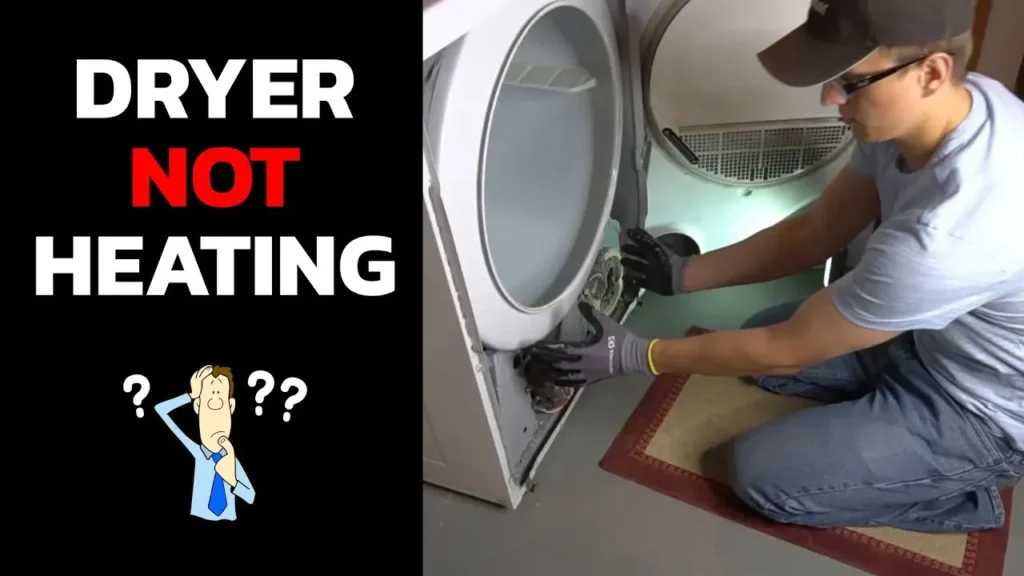
7. Control Board, Timer, or Other Electrical Faults
If you’ve ruled out the above issues and the dryer still won’t heat, the problem may lie in the controls or other electronic parts. These faults are less common but possible.
- Control board/timer: Modern dryers often have electronic control boards that send power to the heater. A malfunctioning board or timer switch could fail to activate the heating circuit. There may be no obvious sign, but an error code on a digital display can hint at issues.
- Malfunctioning start switch or door switch: If the door switch isn’t making contact, the dryer may run but not engage the heater. Test these switches for continuity as well.
- Moisture sensor issues: Some dryers use moisture sensors to shut off early. A broken sensor might misinterpret dryness and cut the cycle prematurely (though usually clothes would stop tumbling too).
- Professional diagnosis: These kinds of problems usually require specialized troubleshooting tools and knowledge. If you suspect the control board, call an expert.
- Bottom line: Defective control components can prevent heating even when everything else seems fine. If all DIY checks fail, it’s time to call a qualified appliance repair technician.
8. Overloaded or Excessively Wet Laundry
While not an electrical fault, overloading the dryer or putting extremely wet clothes in it can make it seem like the dryer isn’t heating. The dryer may still produce heat, but it’s simply insufficient to dry the heavy, wet load quickly.
- Load size: If you packed the drum completely full, try reducing the load size. Overloading prevents clothes from tumbling freely and exposes them to hot air unevenly.
- Very wet clothes: Ensure the washer spun out most of the water. If clothes are dripping, run another spin cycle. Damp, heavy items (like a king-size blanket) may need more time or a smaller load to dry.
- Mixed loads: Mixing very heavy (towels) with light (sheets) can confuse auto-sensing dryers. Separate them if you notice drying issues.
- Check after some time: If the dryer is heating, the drum and air will be hot. Carefully feel for heat inside. If it’s hot but clothes stay damp, try removing some items or running another cycle.
- Bottom line: Make sure the problem really is lack of heat. If you feel warm air and a hot drum but still have wet clothes, it’s likely a load issue rather than a broken heater.
Preventing Dryer Heating Problems
A little maintenance goes a long way. Follow these dryer repair and maintenance tips to avoid heating issues in the future:
- Clean the lint filter after every load. This maximizes airflow and prevents overheating.
- Inspect and clean the dryer vent regularly. Aim for at least once a year (more often in homes that use the dryer heavily). Professional duct cleaning can safely remove stubborn lint.
- Choose the right cycle for each load. Using high heat for thick fabrics (and lower heat for delicates) improves efficiency.
- Don’t overload the dryer. Half-full loads dry faster and more evenly.
- Check the vent hose length and condition. Long, kinked, or foil hoses restrict flow. Use a short, rigid or semi-rigid vent for best results.
- Vacuum under the dryer. Lint can accumulate there too. Pull the dryer out (unplug first!) and vacuum up any dust or debris.
- Schedule professional tune-ups. If you notice irregular cycles or strange noises, getting a technician to inspect components (belts, rollers, sensors) can prevent future failures.
Regular care will keep your dryer running efficiently and safely, reducing the chances of a no-heat emergency.

Frequently Asked Questions (FAQ)
Why is my electric dryer running but not heating?
If an electric dryer runs but won’t heat, the cause is usually electrical. Common culprits include a tripped breaker (one hot leg out of two), a blown fuse/thermal cutoff, or a broken heating element. First, check the breaker box and reset any tripped dryer circuit. Next, clean the lint filter to ensure airflow. If the dryer still tumbles without heat, the heating element or thermal fuse may be open. Testing these requires a multimeter or a technician, as they’re inside the machine.
Why won’t my gas dryer heat up?
For a gas dryer not heating, start by confirming the gas supply is on. Check the wall valve and ensure your home’s gas service is active. Then, ensure the igniter is glowing when the dryer starts – you should hear it click and see a brief orange glow. If not, the igniter or gas valve coils might be faulty. Also inspect the exhaust vent – blocked airflow can trigger the thermal fuse (cutting off heat) even in gas models. If you smell gas at any time, stop and call a professional immediately.
How often should I clean my dryer vent and lint filter?
Clean the lint filter after every load – it only takes a few seconds and prevents fires and poor drying. For the dryer vent duct, aim to clean it at least once a year, or more if you do many loads weekly. Homes with pet hair or carpet fibers near the vent may need more frequent cleanings. If you notice clothes taking longer to dry or the laundry room getting excessively warm, check the vent right away.
Can I fix my dryer that won’t heat myself?
You can handle some fixes yourself: resetting the breaker, cleaning the lint trap and vent, and checking power connections are all DIY-friendly. However, electrical tests (with a meter) and internal repairs (replacing a heating element, thermal fuse, or gas igniter) can be tricky. Gas dryers are especially complex and potentially dangerous, so we recommend a professional for those repairs. When in doubt, it’s safer (and often faster) to call an appliance repair technician to diagnose and fix the issue.
What is a thermal fuse and how do I know if it’s blown?
The thermal fuse (also called a thermal cutoff) is a safety device that breaks the heating circuit if the dryer overheats. It’s usually located on the exhaust duct or blower housing. If this fuse blows, the dryer drum will turn but no heat will be produced. To check it, the dryer must be unplugged and the fuse tested with a multimeter for continuity. A failed (open) fuse needs replacement – it cannot be reset. Important: Only replace the thermal fuse after ensuring proper airflow, or the new one will blow too.
How much does it cost to repair a dryer that won’t heat?
Repair costs vary by issue. Simple fixes like resetting a breaker or cleaning the vent cost nothing but time. Professional service for parts (heating element, thermal fuse, igniter) can range from about $100 to $300 depending on the part and labor. Gas dryer repairs (igniter, gas valve coils) may be on the higher end due to complexity. Always get a quote before approving repairs. Regular maintenance can help avoid costly breakdowns.
When to Call Sarcon Appliance Repair
If you’ve tried these dryer repair tips and your dryer still won’t heat, it’s time to call in the experts. Sarcon Appliance Repair offers fast, reliable service for all dryer brands and models. Our certified technicians can diagnose and fix the problem—whether it’s an electrical fault, a gas component issue, or a tricky control-board glitch. We proudly serve South Central Pennsylvania, including Hershey, Harrisburg, Camp Hill, Mechanicsburg, York, and nearby communities.Don’t let laundry pile up! For same-day service and affordable rates, contact Sarcon Appliance Repair. We’ll get your dryer back to heating properly so you can stay warm and cozy. Reach out today to schedule your repair appointment.


